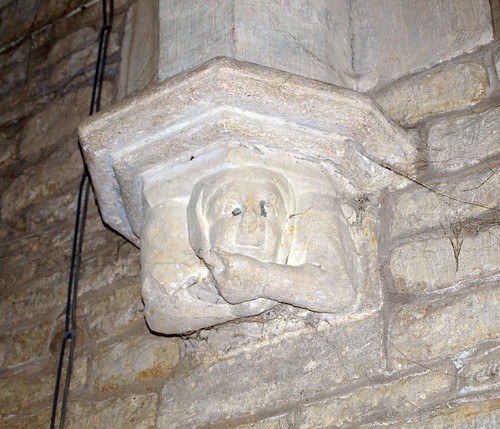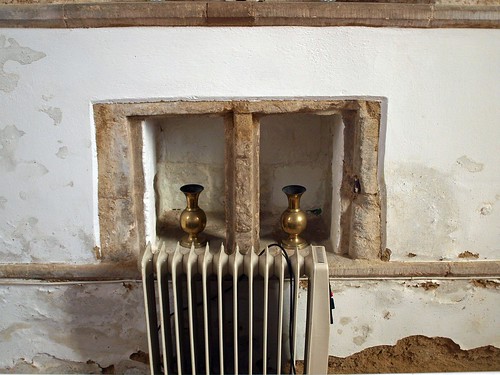ST PETER AND ST PAUL. An E.E. church of high quality, certainly in two of its elements, the steeple and the chancel. The steeple has a W lancet, then a circular window with a quatre-foil, long bell-openings of two lights with bar tracery, and a spire with high broaches and three tiers of lucarnes. The lowest ones are large and of c.1300. The arch to the nave is small and triple-chamfered.* The chancel is late C13 too. The windows are lancets - three very slightly stepped in the E wall - or have Y-tracery. The N doorway has a rounded-trefoiled head. Traces of a S doorway can also be seen. The buttresses are slightly chamfered, and the chamfers end charmingly in a little concavity at the top. Inside, the chancel is quite excellent. It not only has rich shafting to the E lancets, but all along the N and S walls close high blank arcading on shafts - six full arches and at the W and E end the baffling half and two-thirds arches which the E.E. style never minded, though they contradict so much an ideal of purity which we cannot help attributing to it. Below the E window are three recesses, arranged symmetrically - cupboards probably. The chancel arch matches. The nave arcades cannot have been done much after the tower, yet must be later, though not later than the chancel. This dating is based on the fact that the tower in its position presupposes the S arcade where it is, but a N arcade some feet further S. On the other hand, the chancel arch is centred with the nave. So, when the arcades were built, that to the N was set further N than a preceding N arcade or nave N wall had been. The details of the arcades (standard elements) are hardly later than 1300. The clerestory has plain Y-tracery, and that also means late C13. In the S aisle are a W lancet, a late-C13-looking doorway with fine mouldings, and a window with bar tracery. The nave buttresses are chamfered, as in the chancel. There is also a Perp and a Dec window, the latter with reticulated tracery, and a low tomb recess. The N aisle has more reticulated windows, and a doorway with continuous mouldings. So that will be c.1330. Good Perp roofs of chancel and N aisle. In the chancel angels against the intermediate principals, in the aisle figures against the wall-posts, holding shields and various other things. - (PULPIT. With some original Perp tracery. GMCH) - PLATE. Cup of 1634-5, gilt inside, and Paten Cover of the same date.
* The base of the tower was rebuilt in 1877 by Ewan Christian.
ALCONBURY. A delightful village, with tiny white footbridges over the brook, white houses with crumpled-up roofs, and an Elizabethan manor house with dainty gables, it has in its keeping one of the finest 13th century churches in the county, with a 17th century farmhouse and an 18th century barn at the gate. The stately church is famous for its chancel, long and rather narrow, with stones chiselled in the 12th century in its rough walls, and a buttress with a fragment of interlaced carving thought to be Saxon. Very beautiful are the 13th century lancet windows. The 15th century roof is carved with bosses and enriched with eight winged angels, one with a lute and others with wreaths, palms, and shields. There are traces of original painting on the walls, and an unusual communion table on richly carved arches has cherubs and grotesques 300 years old. The clerestory nave is 14th century, built of Barnack stone, the older chancel (originally the church) being built of pudding stone and cement, with sides sloping like the sides of a ship. There are floral bosses in the medieval roofs.
The oak pulpit has 15th century buttresses, the clerestory windows have some 14th and 15th century glass showing canopies and flowers, and there are two stone coffins over 600 years old. Here also is a 17th century chest, a 14th century piscina, and one of the quaintest brasses we have seen, for it has a picture of the 13th century tower as it appeared in 1877 with the spire and belfry supported in mid-air by massive scaffolding. This tower and spire did actually appear like that. Originally built in 1290, the spire remains as its 13th century builders left it, while the tower on which it is set has been taken down and rebuilt. It was judged to be unsafe in 1876 and was taken to pieces stone by stone from beneath the spire, which was left shored up in mid-air while the tower was put together again with the same materials, rising till it met the spire. It was one of the most remarkable pieces of engineering work ever known in this countryside.
The old bridge across Alconbury Brook is 15th century and has four pointed arches. At Alconbury Weston, a mile away, the Brook runs across the green and the stone work of the bridge is said to have come from Coppingford’s medieval church. The hamlet has a few 17th century cottages, and a wet moat in Hermitage Wood, but it has no church, its people walking across the meadows to Alconbury. A mile away the Great North Road joins Ermine Street at Alconbury Hill, where is a high and beautiful milestone crowned with a finial and railed round. On this hill stood the gibbet on which Jarvis Matcham was hanged. It is a name everybody here knows, for it comes into a story which begins at Alconbury, has become a legend of Salisbury Plain, and has found its way into the Ingoldsby Legends. We were told that there were old folk who could remember the mark of the hangman’s rope on the bough of the tree.
The Drummer Boy of Salisbury Plain
In June 1796 two sailors named Matcham and Sheppard were tramping home from Plymouth, where they had been paid off, when a thunderstorm burst over them as they were nearing Woodyates Inn on Salisbury Plain, the inn which was kept by the first known ancestor of Robert Browning. Matcham began to run wildly about, screaming to his shipmate to protect him from ghosts, and declaring in his frenzy that stones were rising up and dashing themselves against him.
Sheppard did what he could to calm the man, but Matcham continued to dodge hither and thither, now shouting to his friend to keep that blood-stained drummer boy from him, and pointing to a post where, as the thunder rolled overhead, his terrified eyes could see the boy drumming at him. When the storm had passed Matcham confessed to his mate that seven years before he had murdered the drummer boy of the regiment in which he had enlisted near Huntingdon. Robbing him of six gold guineas, he had escaped to London and become a sailor; but wherever he went the face of his victim haunted him, so that he knew no peace by day or night. Preferring death to a haunted life, Matcham tramped on to Salisbury and surrendered. The story was investigated and he was hanged.
The oak pulpit has 15th century buttresses, the clerestory windows have some 14th and 15th century glass showing canopies and flowers, and there are two stone coffins over 600 years old. Here also is a 17th century chest, a 14th century piscina, and one of the quaintest brasses we have seen, for it has a picture of the 13th century tower as it appeared in 1877 with the spire and belfry supported in mid-air by massive scaffolding. This tower and spire did actually appear like that. Originally built in 1290, the spire remains as its 13th century builders left it, while the tower on which it is set has been taken down and rebuilt. It was judged to be unsafe in 1876 and was taken to pieces stone by stone from beneath the spire, which was left shored up in mid-air while the tower was put together again with the same materials, rising till it met the spire. It was one of the most remarkable pieces of engineering work ever known in this countryside.
The old bridge across Alconbury Brook is 15th century and has four pointed arches. At Alconbury Weston, a mile away, the Brook runs across the green and the stone work of the bridge is said to have come from Coppingford’s medieval church. The hamlet has a few 17th century cottages, and a wet moat in Hermitage Wood, but it has no church, its people walking across the meadows to Alconbury. A mile away the Great North Road joins Ermine Street at Alconbury Hill, where is a high and beautiful milestone crowned with a finial and railed round. On this hill stood the gibbet on which Jarvis Matcham was hanged. It is a name everybody here knows, for it comes into a story which begins at Alconbury, has become a legend of Salisbury Plain, and has found its way into the Ingoldsby Legends. We were told that there were old folk who could remember the mark of the hangman’s rope on the bough of the tree.
The Drummer Boy of Salisbury Plain
In June 1796 two sailors named Matcham and Sheppard were tramping home from Plymouth, where they had been paid off, when a thunderstorm burst over them as they were nearing Woodyates Inn on Salisbury Plain, the inn which was kept by the first known ancestor of Robert Browning. Matcham began to run wildly about, screaming to his shipmate to protect him from ghosts, and declaring in his frenzy that stones were rising up and dashing themselves against him.
Sheppard did what he could to calm the man, but Matcham continued to dodge hither and thither, now shouting to his friend to keep that blood-stained drummer boy from him, and pointing to a post where, as the thunder rolled overhead, his terrified eyes could see the boy drumming at him. When the storm had passed Matcham confessed to his mate that seven years before he had murdered the drummer boy of the regiment in which he had enlisted near Huntingdon. Robbing him of six gold guineas, he had escaped to London and become a sailor; but wherever he went the face of his victim haunted him, so that he knew no peace by day or night. Preferring death to a haunted life, Matcham tramped on to Salisbury and surrendered. The story was investigated and he was hanged.



No comments:
Post a Comment